Mongolia, Army, Modern Mongolia, Economics. Mongolia Army: History and Modernity
The Armed Forces of Mongolia, on Mongolian (Mongol Zhlsykin ZEVSEGT Hүchin), were based on the Mongolian People's Army. To date, the Armed Forces of Mongolia have 8,600 people in their composition, of which 3300 urgent service soldiers (data as of 2007). The service life in the Mongolian army appeal is 12 months. Cravale age in Mongolia from 18 to 25 years old, there is a delay for students and large fathers. In reserve of land forces, 137,000 people are listed.
In Mongolia, militarized formations have a number of 7.2 thousand people, of which 6 thousand people serve in the border troops (4.7 times. Man soldiers of the urgent service), and in the internal 1.2 thousand people, respectively, of which 800 Man deadlocks.
Mobilization resource is calculated by 819 thousand people, of which 530.6 thousand people are suitable for military service.
Military budget in Mongolia is not relatively not large and amounts to 2007 by $ 20 million.
Spump from the call to the army of Mongolia
In Mongolia, there is officially the right to spout from calling for military service. To bought off from the service in the army, the conscript should be made to the state treasury, as of 2009, 2.3 million tuggers, that translated into US dollars is about $ 1,600.
- Ground troops - Commander Colonel G.Engbaatar
- Forces air defense - Commander Colonel S.Dashdelug
- Border Troops - Commander Brigadier General Ts Eargelang
- Internal troops - Commander Major General D. Sandag Celebration
- Head of the General Staff - Lieutenant General Ts. Bambazhav.
At the turn of the 70-80s. In the Monogol Ground Forces there were three motorized rifle divisions, Air Force and air defense. At the same time, there was one - the only air file in Nalaikha), consisting of fighter (MiG-21), helicopter (Mi-8) and transportation squadrons.
Air defense - anti-aircraft missile division (C-75) in Choibalsan.
Modern position
Military budget $ 28.0 million (2004).
Regular sun 8.6 thousand people. (including 3.3 thousand Wed. ate).
Packing: By call.
Service life 12 months. Reserve (SV) 137 thousand people.
Militarized formations - 7.2 thousand people, including 6 thousand border troops (including 4.7 thousand Wed. El.), internal troops -1.2 thousand (including 800 cf. El.). Mob. Resources of 819 thousand people, including 530.6 thousand suitable for military service.
SV: 7.5 thousand people, 6 military districts, artillery regiment, light response PB (1 in the formation stage), airborne battalion.
Armament: 370 tanks (T-54, T-55, T-62), 120 BRDM-2, 310 BMP-1,150 BTR-60, about 300 guns PA, 130 RSZO BM-21,140 mortars, 200 anti-tank gauges 85 and 100 mm.
Air Force and air defense: 800 people, b. from. No, 13 b. in. Airplane and helicopter park: 9 MiG-21 (on storage), 6 An-2.6 An-24, An-26, An-30.2 Boeing 727, A-310-300,111 Mi-24.2 Mi- eight. Ground forces and air defense agents: 150 memory and 250 CRK.
Source: Directory "Armed Forces of Foreign Countries", 2005
Mongolia Armed Forces Military budget $ 30.2 million (2001). Regular armed forces - 9,100 people. (including 300 military builders and 500 people. - l / s). Reserve (SV) 137,000 people. Militarized formations - 7,200 people, incl. Border troops 6000 people, Ministry of Public Security - 1200. Packing: By Call. Service life of 12 months. Mobilization resources - 702.7 thousand people, incl. Announced military service of 457.8 thousand
Modern troops: 7,500 people, 7 motorized rifle and one artillery brigade, light response regiment, airborne battalion. Armament: 650 tanks (T-54, T-55, T-62), 120 BRDM-2, 400 BMP-1, 250 BTR-60, 450 guns PA, 130 RSZO BM-21, 140 mortars, 200 anti-tank cannons of caliber 85 and 100 mm.
Air Defense: 800 people, 9 combat aircraft, 11 combat helicopters. Airplane and helicopter park: 9 MiG-21, 15 An-2, 12 An-24, 3 An-26, 2 Boeing 727, 11 Mi-24. Ground air defense: 150 memory and 250 CRKK. (According to the materials of the magazine "Foreign Military Review")
Principles of formation
Citizens of Mongolia Citizens take place within one year, however, everyone has the right to officially pay off the service, paying the state established by the state monetary compensation. (2003, 830 thousand Tugrykov, OK. 730 $). This amount is established before the start of the spring call and is determined annually on the basis of calculating the content of one serviceman of the deadlines, including the costs of uniform, nutrition, medical services, educational work, as well as other necessary costs.
In accordance with the legislation of Mongolia, evasion from the actual military service without paying relevant compensation is punishable by imprisonment for a period of 3 to 7 years.
The passage of alternative service occurs in military units and Mongolia Civil Defense Services at support work. From January 4 to January 20, 2010, the next military registration of Mongolia citizens aged 18 to 50 years passes in Mongolia. The military accounting commission must bring with them a civil service, a military ticket to a civil serving, a military ticket of an order officer. Military accounting is organized by the heads of the Horo and the designated working groups in the administrative premises of Horo. According to the law, all male citizens aged 18 to 50 years old are subject to military registration, women with a military specialty, officers under 55 years old and the highest officers or generals under 60 years of age.
International Military Cooperation of Mongolia
Since 2004, the military personnel of the Armed Forces of Mongolia within the framework of military-political cooperation are serving in Iraq (132 Mongolian soldiers), in Afghanistan (50), in Sierra Leone (250), Kosovo and other hot spots.
Since 2003, Mongolia has been held in Mongolia Khaan Quest ("In search of a khan"). In 2006, the United States achieved the inclusion of Khaan Quest to the register of international exercises, now they are held under the auspices of the UN. They participate in these countries such as Japan, India, Bangladesh, Tamand, Fiji. Up to 1 thousand military participates in the exercises. Russia and China are invited to the teachings as observers.
Exercises are held at the landfill training Center The Armed Forces of Mongolia "Tanwan Tolga". During the teachings, the military was implemented by the methods of combat operations on the ground, studied martial arts, organization and rendering medical care In combat conditions.
In 2008, Khaan Quest exercises were held in September, a month later than usual: on the eve of the Olympics in Beijing, the Chinese authorities stated that they would not provide American military helicopters sent from US military bases at Okinawa (Japan) and in South Korea, an air corridor. Beijing also warned the United States and Mongolia about what he considers it inappropriate to conduct exercises during the period of the Olympiad. In 17-day exercises, 880 military personnel from Mongolia, USA, India, Thailand and Nepal took part.
Military cooperation with Russia
Cooperation with Russia in the military field is restored, in particular, the preparation of military personnel in the Russian military is resumed educational institutions. The modernization of armament of all Mongolia has begun. According to the agreement, the Russian side supplies Mongolia two search and rescue helicopters Mi-171e, equipped with special equipment, onboard computer and an additional locator, is able to fly to any weather at a speed of 220 - 250 km per hour and transport more than 30 parachutes or rescates at a distance of 950 - 1000 km with a load mass from 300 to 600 kg.
There are negotiations on the supply of combat aircraft. For the operation of these combat machines, more than 20 people on military-technical specialties have already been trained. Since 2006, 60 people have been trained in military schools in Russia and in a preferential basis and in order of free assistance, and in 2008, more than 50 people from Mongolia are trained. In addition, in mid-August, there are 10 servicemen from among the terms of contractors, military personnel undergoing military service and from the personnel of junior military specialists will go to study in Russia.
On November 20, 2009, on the territory of the Mongolian military unit No. 337, a ceremony of transmission of weapons and equipment from Russia took place. Bronetransporters, tanks, heavy trucks, aircraft entered here in accordance with the cooperation agreement, signed by the ministers of the defense of the two countries A.E.Serdyukov and L. Boldo. Upgrading of weapons and technology is held in the framework of the Mongolia Armed Forces Program until 2015 in accordance with it, such an investment in the defense industry has been received in the defense industry. last years. A great place in the program is the update of widespread weapons and techniques produced in the Russian Federation.
On September 12, 2010, the joint Russian-Mongolian teachings "Darkhan-3" ended in Buryatia, the purpose of the teachings opposition to terrorism.
There are some projects for the construction of roads. Currently, for example, construction from the east to the west of the so-called "Millennium Road".
Mongolia has a number of internal airports. The only international airport is Changis Khan International Airport near Ulan Bator. Direct air communication exists between Mongolia and South Korea, China, Japan, Russia and Germany. MIAT MONGOLIAN AIRLINES is the largest carrier in Mongolia, and provides both domestic and international flights.
Sea fleet
Mongolia is the second (after Kazakhstan) on the territory of the country in a world that does not have any ocean. However, this did not prevent her in February 2003 to register his ship registry (The Mongolia Ship Registry PTE LTD). Starting from the moment of registration, Mongolia is systematically increasing the number of ships under its flag.
Army
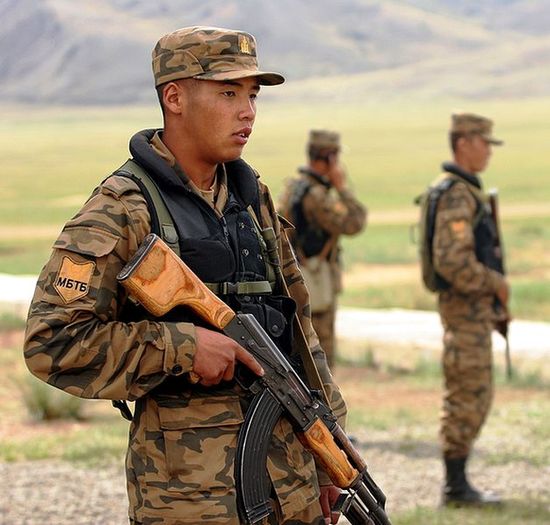
Number Armed Forces 8.6 thousand people. (2007) The acquisition is carried out by call, the service life is 12 months. Men at the age of from 18 to 25 years old are called. Mobilization resources - 819 thousand years., Including 530.6 thousand people suitable for military service.
Currently, a reform is carried out in the Mongolia army, aimed at increasing the combat capability and updating the IWT technical park. In this process active participation Take Russian, American and other specialists.
Since 2002, Mongolia has been participating in peacekeeping activities. During this time, 3200 Mongolian servicemen took part in different operations. 1800 of them served under the mandate of the UN, and the remaining 1400 were under an international mandate.
Modern Mongolia
Since 1990, due to the collapse of the Socialist Camp and the collapse of the USSR, democratic and economic reforms occurred in the country: collective agriculture, industry, trade and service, several opposition parties arose, which were opposition of the MHRP.
Economy
Although the larger number of people live in cities, the Mongolia economy is still concentrated in industries such as agriculture and mining. Such mineral resourcesAs copper, coal, molybdenum, tin, tungsten and gold make up a significant part of the industrial production of the country.
In the period from 1924 to 1991 MNR received major financial and economic assistance from the USSR. The peak of providing this aid accounts for one third of its GDP. In the early 1990s and next decade, the Mongolia economy experienced a strong decline with subsequent stagnation. Extensive droughts in the summer and winter of 2001 and 2002 had a serious impact on agriculture and led to a noticeable slowdown in the country's GDP growth. In Mongolia high level inflation. The global financial crisis caused a decline in many industries, depending on exports and investments from abroad.
Due to the harsh continental climate of Mongolia, agriculture remains vulnerable to natural disasters in the form of severe drought and cold. The country consists of small arable land, but about 80% of the territory is used as pastures. Most of the rural population is occupied by grazing livestock consisting of sheep, goats, cattle, horses and camels. Mongolia has a greater amount of cattle per capita than any other country in the world. Wheat, potatoes and other vegetables are also grown, moreover, tomatoes and watermelons.
PPP GDP: 9.48 billion dollars (2008).
GDP per capita for PPS (2008): 3200 dollars.
Unemployment level: 2.8% (2008).
Export: ($ 2.5 billion in 2008) - copper, molybdenum concentrate, meat, live cattle, animal husbandry products, fluff of goat, wool, skins, stone coal.
Major buyers in 2008 - China (76%), Canada (9%), Russia (3%).
Import: ($ 3.6 billion in 2008) - Fuel, Machinery, Cars, Food, Industrial consumer goods, chemicals, building materials, sugar, tea.
Main suppliers in 2008 - Russia (35%), China (29%), Japan (8%).
External debt - 1.6 billion dollars (in 2008).
Mongolia is a member of the World Trade Organization (since 1997).
The main trading partners of the country are China and Russia and the economy of Mongolia largely depends on these countries. In 2006, 68.4% of the export of Mongolia was carried out in China, while imports accounted for only 29.8%. Mongolia imports about 95% of petroleum products, and a significant proportion of electricity from Russia, which makes the country extremely dependent in economic terms.
95 years ago, March 17, 1921, the Mongolian army held the first combat operation in its history. 400 Mongolian partisans defeated the two thousandthly garrison of Chinese altan-boulac. Today, the constant number of the Armed Forces of Mongolia is about 10 thousand bayonets. How serious combat power is the heirs of the Army of Genghis Khan.
Currently, the Mongolia's land forces is a slightly less than 10 thousand people consist of six motorized rifle regiments, one artillery regiment and three battalions - airborne, construction and light infantry battalion of rapid response. The tests are only a third of the total number of ordinary and sergeant composition, The rest serve under the contract.
In the Mongolian army serve 20 generals.Every year on April 24, the country of Mongolian generals is celebrated. On this day, on the square of Genghis Khan in the Ulan Bator solemn events and masts of military equipment, "reflecting the power and strength of the Mongolian Armed Forces." The highest title in the Mongolian army "Lieutenant-General" today is the head of the General Staff of the Armed Forces of Mongolia Cerendehidine Bambazhav. The Minister of Defense of Mongolia Cerendishnin Tsolmon is a civilian.
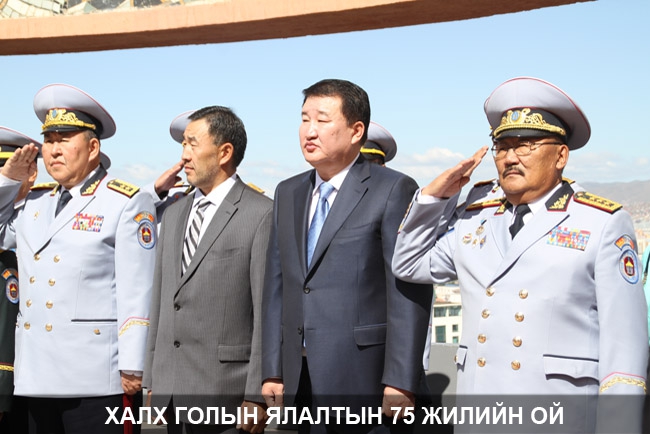
Mongolia's military budget in 2015 amounted to $ 70 millionWhat is equal to the value of one Russian Su-35 or 35 T-95 tanks fighter. The army is armed with the equipment of Russian and Soviet production. The exception is the Israeli automata "Galil", which armared several units of special forces. A few years ago, Mongolia's leadership expressed interest in the purchase of American military transport aircraft C-130 "Hercules".
In the annual rating of Military Power States Global Fire Power (GFP) Mongolia takes 85th placewhere I am inferior to Nepal and ahead of two points Lithuania. The basis of the shock power of the Mongolian army according to the GFP version is tanks - a total of 400 T-55, T-62 and T-72 machines of various modifications. Mongolia's land forces consist of 7 motorized rifle and one artillery brigade, a light shelf of rapid response and an airborne battalion.
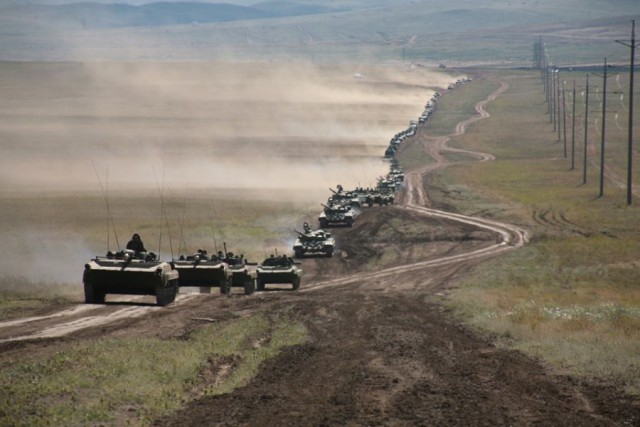
The largest acquisition of the Mongolian army in recent years has become 100 modernized T-72A, 40 armored personnel carriers of BTR-70M and 20 BTR-80. Technique in 2014-20016 was charged for the Ministry of Defense of the Russian Federation as part of military-technical assistance. Newist aircraft Mongolian Air force is the Mi-171 helicopter (2 units). Total Mongolian aviation has 10 transport aircraft and 7 helicopters.
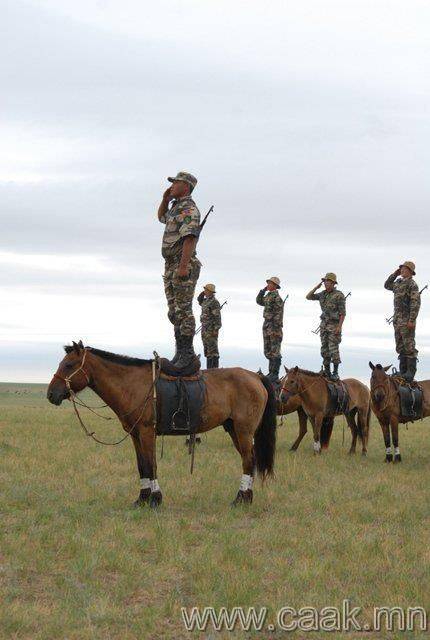
In the photo: Mongolian martial contes, 2014
In Mongolia acts official law on sputum obs military service By call. The amount of sputter is about $ 2.5 thousand. In 2013, about 1600 conscripts took advantage of this right. The total number of military personnel of the Mongolian army, undergoing a call service is 3300 people, as a rule, these are young people from poor families.
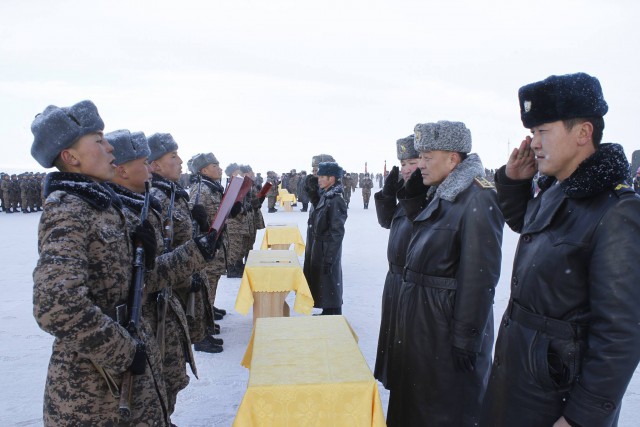
More than 10 thousand Mongolian servicemen took part in the UN peacekeeping operations. The largest Mongolian peacekeeping contingent of 850 fighters is now deployed in Sudan. About 50 Mongolian fighters are served as part of the international coalition in Afghanistan. Mongols guard the base of Camp Marmal in Mazar-Sharif. Previously, the Mongolian servicemen (150 people) as part of the international coalition participated in the operation in Iraq. Two Mongolian fighters prevented a breakthrough to the database of the database of a suicide bomb at the explosive truck.
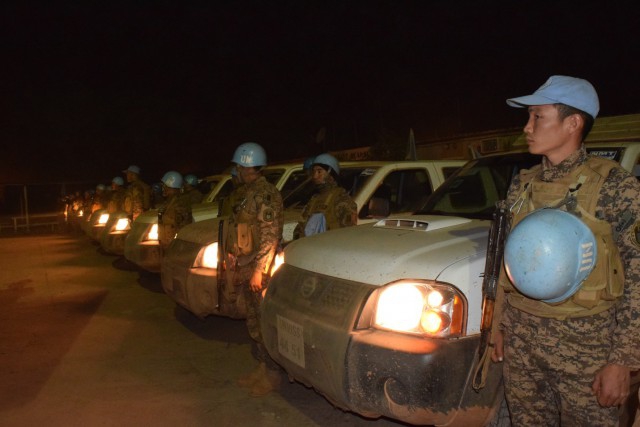
In the photo: Mongolian peacekeepers in Sudan, 2015
The oldest compound of the Armed Forces of Mongolia is 016th. Marshal Choibalsan Motor-string brigade.
Formed on March 1, 1923 by Resolution No. 3 of the Government of Mongolia as the 1st Bronnescadron MNA. Further, this compound, reformed in 7 mechanized armorboil, took an active part in the events at the Khalchin-Goal of 1939 and in the war with Militarist Japan in 1945.
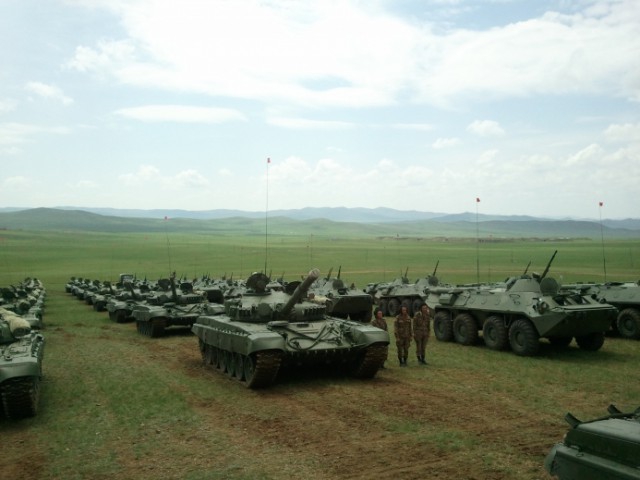
In 1978, with the exacerbation of the Sino-Vietnamese relations and the strengthening of the USSR military pressure to China, due to its aggression in Vietnam, the brigade was enhanced by armored vehicles and was reorganized into a motorized rifle division.
From the composition of which was formed 016 brigade.
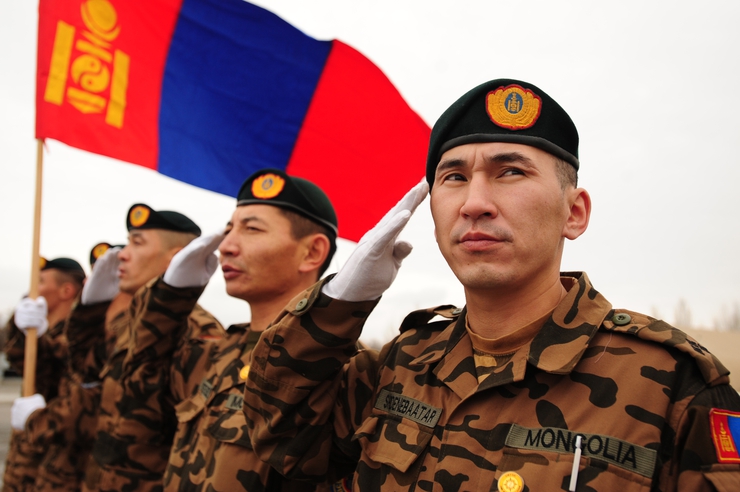
From the ranks of the joint award of Mongolia, the title "Hero of Mongolia" were awarded 10 servicemen. Since 2012, the Brigade has been reoperacted by combat technique coming from Russia, Germany and the United States. So from Russia to armared the compounds received more than 50 T-72A tanks, about 40 BTR-70M and BTR-80, as well as motor vehicles.
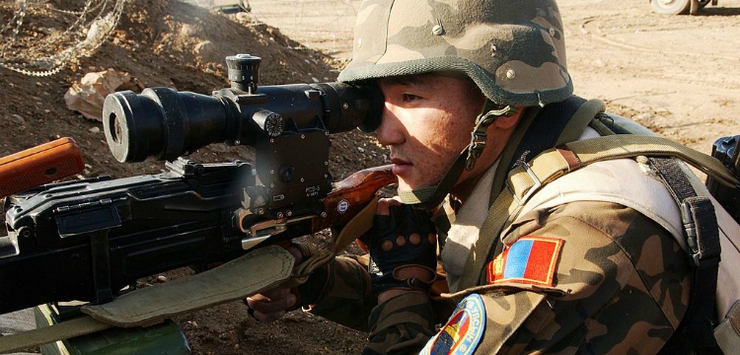
In the photo: Mongolian machine gunner in Iraq. Dawn M. Price, U. S. Air Force, 2006
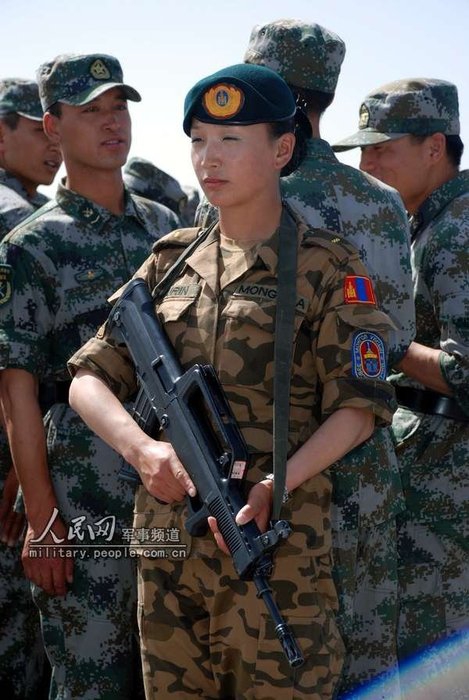
On the picture. Joint exercises with the People's Army of China.
Main article: Mongolian People's Revolutionary Army
The basis of the regular Mongolian army was partisan detachments, led by the Mongolian People's Revolutionary Party.
In the summer of 1919, in connection with the penetration of the Mongolian territory of Russian White Guards from the Urga region, the equestrian detachment was transferred to the Western outskirts of Mongolia, which was commanded by Khatan-Batar Maksarzhav. The detachment acted in the areas of Chem, Hamchig, Poz and Tanna. In the Hamchig district, the Mongolian detachment discovered a detachment of Belocazakov and attacked them at the moment when they attacked the RKKA division. After the end of the battle, the Red Army was presented to the commander of the detachment of Tachantka (which became the first machine-gun tachish, which entered the arms of Mongolian detachments).
The decision on the creation of the army was made on February 9, 1921.
March 13, 1921 four horse shelves were formed from partisan detachments (which were headed by B. Punchag, B. Cerendorg, Hass Batar and Bazaarsad), March 16, 1921 it was decided to transition to the offensive.
On March 17-18, 1921, the Mongolian army implemented the first combat operation - about 400 partisans attacked Kyakhta and defeated the garrison in Altan-Bulak, after which they successfully pursued the enemy to Barun Hara (Western River).
On April 10, 1921, the Central Committee of the Central Committee and the Interior Government of the MPR appealed to the SNK of the RSFSR asking for assistance against the units of the White Armies operating in the territory of Mongolia.
At the end of May 1921, the main headquarters of Maxaheda was in the city of Kyakhtinsky Maimachen, it also passed the creation and reform of the Mults detachments (at that time, the main source of weapons of MNRA were trophies, therefore weapons were weapons of various systems, when re-equipped the detachments Simplicate weapon).
June 6, 1921 Allied Ungerna Mongolian Equestrian Detachment Bair-Gun tried to suddenly attack Maimachen, Markra, and a group of Soviet military specialists (who commanded H. B. Kanukow) beat off, the attackers left 40 people killed and wounded and retreated, Bair-Gong was taken captured.
On July 22, 1921, a major Mongolian detachment who commanded the Hatan Bator Maksarzhav, defeated the detachment of Beloamigrants from the Ungerna Army in the city of Ulyasuti.
In the future, Mongolian troops together with the Red Army and the People's Revolutionary Army of the Far Eastern Republic participated in the battles in the territory of Mongolia with Chinese militarists and the Asian division R. Von Ungern-Sternberg.
In August 1921, the military specialists of the fifth of the People's Revolutionary Army developed a draft organization of the military system on the basis of Soviet military experience. It was based on the principle of territority in military appeals and the formation of a permanent personnel army.
Simultaneously with the creation of an army based on the system of equestrian postal stations (existing before the revolution of 1911, but by 1921, a military supply system was created only in part): station (" urtones") Created at a distance of 25-30 km, had a water source, renewable reserves of the provisional, fuel and spare horses.
In December 1921, the Mongolian detachment, which was commanded by Khatan-Batars Maksarzhav, was surrounded and forced to fold the weapon acting on the Mongolian territory a detachment of the White Guards, who commanded a colonel of hobots.
Heads of the General Staff during the first two years were the Soviet military specialists: Lyatta (March-April 1921), P. I. Litvinsev (April-September 1921), V.A. Huva (September 1921 - September 1922), S. I. Popov (1922-1923).
In June 1923, the first group of Soviet military advisers was sent to Mongolia - 12 people (D. I. Kosich, V. I. Dmitrene, L. Ya. Weinner, A. O. Petrov, N. M. Headsetsky, N. with . Sorokin, A. S. Orlov, Beloglazov, Boyko, Petrovsky and Chamine), which remained in the MTR until 1925.
In the summer, in the summer of 1923, the basis of the Mongolian army was the cavalry parts. Private curses were dressed in dark blue cotton bathrobes "Dali", soft boots "Guitules" and were armed with carbines, sabers and peaks. The commanders wore silk robes of birds of coloring, islandic caps and were armed with pistols and revolvers of various systems. Before the arrival of the Soviet military mission in the cavalry units, there was no permanent horse lineup - each part had 2-3 times more horses than was required by the charter that were collected in herd. Thus, fighters and commanders did not have permanent horses, which excluded the possibility of combat training and training of horse-drawing. The artillery of the Mongolian army consisted of 76 mm Russian instruments of the 1900 sample and 75-mm Japanese guns. In addition, the presence of one trophy 75-mm French-made tool, but it was not possible to use it (and after the creation of the Military Museum he was transferred to the museum).
At the initiative of the Soviet Military Mission, the first industrial enterprises for the production of military products were created in the MLR (first shore workshops in Urge, where the manufacture of the Russian Cossack seat was launched, replaced previously used traditional Mongolian wooden sidelles, then shoe and sewing workshops). Following this, in the Mongolian army, a single uniform was introduced on the RKKK - trousers and gymnastrics of protective color, gray seats and boots.
In September 1923, on the outskirts of Urga (in the former building of the joint-stock company "Mongolor"), the first Cavalry School and Artillery School were opened.
Since 1924, the publication of the Ardian Chereg newspaper began for military personnel.
In 1925, Mongolian soldiers abandoned the wearing braids (previously considered necessary element The appearance of the Mongolian warrior).
On October 16, 1925, a law on universal military duty was adopted in Mongolia, since 1926, the creation of temporary detachments of the national militia, in which the initial military training was held.
Until 1926, the signs of Lama Emchi were preserved in the states of parts, their substitution began medical workers.
In the mid-1920s, MPR participated in the provision military assistance Chinese troops Feng Yu-Xian. Mongolian soldiers participated in the delivery of Soviet weapons from Verkhneudinsk to Kalgan, the Mongolian government referred to him by the ammunition party, several dozen arrivals from China's cadets-Barguts were trained in Military Schools.
In 1929, the Council of National Defense was created.
In early 1930, the USSR handed over the first armored vehicles - six Ba-27 and several Fiat Armors and Austin, two more Ba-27 were later transferred. Since September 1930, the publication of the newspaper "Ulaane OD" began.
In 1932, a group of military specialists and border guards arrived in the USSR in MNR, which assisted in the creation of the MNR border troops (the first border parts of the MTR were created from the divisions of the 2nd Cavalry Corps of the MPR and began to function in 1933).
In 1932 - 1935 The Japanese-Manchurian troops have repeatedly provoked armed conflicts in the border strip (during the fighting for the protection of the Border MNR, several dozen Mongolian soldiers and commanders were awarded orders and medals, and two - pilot D. Damberel and ML. Commander Sh. Gorgor - became heroes MNR). One of the most serious incidents during this period of time was the capture of the Japanese troops of the Mongol border post in the Khalkhin-Sumu area with the territories adjacent to it.
In 1934, Military expenditures of the MTR amounted to 34.7% of the state budget. From May 1935 to March 1936, Japanese troops committed several times to the territory of the MPR in the territory of the Bulan-DERS, Agat Dalan and other places, in connection with the increase in military danger, the MTR government decided to increase military spending. During this period, an increase in the number and increased combat capability of the Mongolian army, technical units were created in the cavalry parts, as well as the first aviation and armored parts.
On November 27, 1934, the USSR and the MNR concluded an agreement on mutual support. Supplement Yushkevich Anna Tarasovna: In 1929-1932 in Mongolia, by order of the 4th Department of the Republic of Kazakhstan, I was on the command trip Yushkevich Taras Vasilyevich. Headed the suppression of a prognapon insurgency in the Gobi desert. For which he was awarded the orders of the War Red Banner of the USSR and MPR. At this time, Mongolia's army was headed by Marshal Gaelgornzhine Damid. Subsequently, repressed, like Yushkevich.
In January 1936, the situation on the border of the MNR and Manyzhou was complicated, in the following months There were cases of invasion of Japanese aircraft into the Airspace of the MNRs and the shelling of border outfits and the border making MTR from the territory of Manzhou. In addition, from January 16 to May 11, 1936 in the areas of Highlast, goal, Nuryn-Oboy and Bayan-Over the border and penetrate the territory of the MPR for more than 20 times, sabotage groups were tried.
On March 12, 1936, a protocol on mutual assistance was signed between the USSR and the MNR.
On the same day, on March 12, 1936, the first combat use of armored vehicles of the Mongolian army took place: the platoon of armored cars, which was commanded by Senior Lieutenant Sreter, caught up and attacked the Japanese-Manchurian detachment, who made an attack on the Mongolian border guarding Bulun-Dersu. The appearance of Mongolian armored vehicles has become complete surprise For the Japanese Manchur, they immediately started the retreat to the border on four trucks, shooting out of the rifles. Not paying attention to the opponent's rifle fire, the Mongolian armored vehicles went on rapprochement and opened fire from machine guns on trucks, as a result two trucks with infantry were shot, there were losses in two other trucks that managed to cross the border (later on the persecution route were found The thrown rifles and the corpse of the killed officer, which fell out of the body of an escaped truck).
In 1943, the Institute of Military Commissars The Institute of Military Commissars was abolished, who were replaced by the Deputy Party and Political Work officers.
In October 1943, the Officer School named after the Sukhche Bator was opened. The preparation of team frames of the Mongolian army was taken by the experience of the Soviet troops obtained during the Great Patriotic War.
In 1944 he was adopted new law On the general military duty, the titles of generals and officers were introduced.
On August 10, 1945, the Government of the MPR in accordance with the Soviet-Mongolian Agreement on the mutual assistance of 1936 declared a war of Japan.
At the end of 1945, armed gang of deserters from the Army of the Romintang crossed the Branch of the MTR from Mount Mount Mergen and reached Bulgansky Somon, capturing mongolian Protection Caravan - At the same time, one Mongolian border guard was killed and one more - heavily wounded (wounded hit the bayonet through a coat and left to die, because the violators hurried faster to leave the place of shootout). The attackers moved to one of the border villages, but the gang was surrounded and destroyed by the alarm of the army units and border guards of the MPR.
On February 27, 1946, the USSR and the MNR concluded a new agreement on friendship and mutual assistance.
On July 8, 1948, the detachment of the army of the homindan is a number of 136 people by recruiting the Sino-Mongol border, which entered into battle with the border violators border Outfit MNR It was destroyed, in the pursuit of the attackers, the army units and border guards of the MNR took part in the persecution. Three dead border guards MNR He became the heroes of the MTR (posthumously) and were forever included in the lists of the personnel of the border shop.
On February 27, 1951, the MPR was adopted by the law on the protection of the world, who established a punishment in the form of imprisonment for the propaganda of war.
On May 31, 1960, the PRC and the MNR concluded an agreement on friendship and mutual assistance.
On January 15, 1966, the USSR and the MNR concluded a new agreement on friendship, cooperation and mutual assistance.
